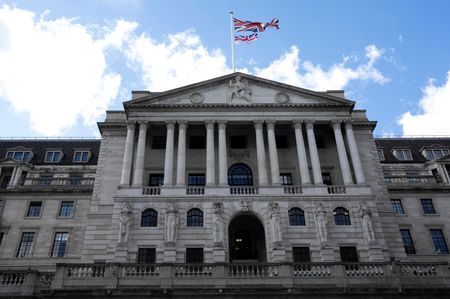By Phoebe Seers and Tommy Reggiori Wilkes
LONDON (Reuters) -The Bank of England is preparing to ease parts of Britain’s bank ring-fencing regime while opposing a major reform sought by lenders, sources said, as the central bank seeks to ensure core protections are preserved amid a government review.
Lenders must separate their retail businesses from other activities such as investment banking under ring-fencing rules, a major piece of post-financial crisis regulation designed to shield depositors and taxpayers in a crisis.
British finance minister Rachel Reeves in July committed to “meaningful” reform, part of government efforts to slash red tape to boost economic growth.
The rules kick in for banks with more than 35 billion pounds ($46.1 billion) in retail deposits and cover Lloyds, NatWest, HSBC, Barclays and Santander UK. Critics argue that ring-fencing hampers Britain’s international competitiveness and say dismantling it would free up capital for lending.
Banks have lobbied Britain’s finance ministry – which has the final say on major changes – to be allowed to use some of the 35 billion pounds that a non-ring-fenced bank can use to fund other activities like investment banking, people at two of the lenders said.
However, officials at the BoE’s regulatory arm, the Prudential Regulation Authority, are against such a proposal, describing it as akin to taking down the fence, one of the sources familiar with the matter said, speaking on condition of anonymity.
Instead, the BoE is open to smaller changes, such as permitting essential back-office functions to be shared across the two entities and allowing activities such as vanilla derivatives to take place inside the ring-fenced unit, the person added.
Changing the prohibition on shared services would be easier to do as it forms part of the regulator’s own rule book.
The PRA declined to comment. The finance ministry did not respond to a request for comment.
“NEXT BEST THING” AFTER SCRAPPING RING-FENCING
Reeves said in her July speech promising a shake-up of ring-fencing that regulation was a “boot on the neck of businesses”.
BoE Governor Andrew Bailey said the following week he disagreed with that description and defended ring-fencing, stressing that regulators “can’t compromise on basic financial stability”.
The rules, one of the commercial bank executives said, were designed before the growth of the UK retail arms of international banks, pointing to JP Morgan, which has expanded its retail Chase Bank in Britain but sits below the threshold. Lenders below the threshold can use deposits for activities such as investment banking.
An official at another bank described access to the 35 billion pounds as the “next best thing” beyond scrapping the regime entirely.
The PRA is set to present its reform proposals together with the finance ministry in early 2026, the second person familiar with the matter said.
The PRA’s CEO, Sam Woods, helped design ring-fencing, which came into force in 2019. His second five-year term ends in June.
Barclays, which built a separate services division for both its retail and investment banks, is the only major British lender in favour of current rules.
($1 = 0.7596 pounds)
(Reporting by Phoebe Seers and Tommy Reggiori Wilkes, editing by Ed Osmond)











